1.Description - how it looks
Cinquefoil is a genus consisting of 300 annual, biennial or perennial species of herbaceous plants or deciduous shrubs with woody stems at the base.
Shoots in different species can be both vertical and lodging. The semi-shrubs are not tall, they are distinguished by a lush, spreading crown formed by repeatedly branched shoots. When in contact with the soil, branches are often rooted low above the soil surface.
Most often, plants have a powerful creeping rhizome located superficially.
Leaves are green, often deeply dissected, contain oblong-oval segments with a serrated edge, arranged alternately or collected in whorls. Young stems and leaf petioles often have sparse pubescence. Each leaf can consist of 3 - 15 small segments and small stipules.
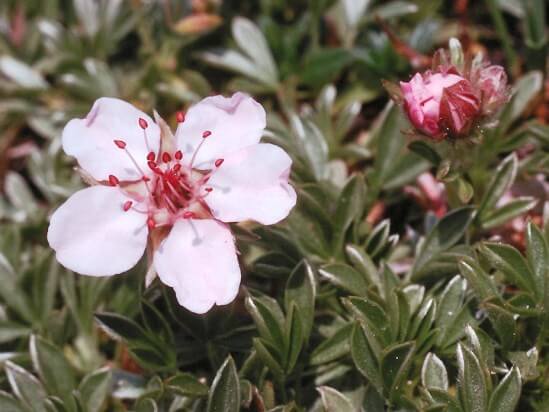
The flowers are often solitary, wide open, cupped, small, often appear on the tops of the shoots, consist of 4 - 5 wide petals of yellow, white, orange, pink or red. In some species, you can find low-flowered inflorescences with 5 - 6 buds in each - umbrellas, panicles or shields. By their appearance, the flowers of Potentilla resemble the common buttercup, which is related to it.
After flowering, in the case of cross-pollination, the plants form small fruits - seed pods with large, oblong, brown seeds. Full maturation of the seed pods occurs within 3 weeks after pollination. Each seed box contains several dozen seeds. In ornamental gardening, semi-shrub forms of this genus are most often grown.
There are so-called "folk" names for Potentilla - for example, the name "five-leafed" is associated with its appearance - the leaves of some species resemble the limb of mammals - they consist of 5 fingers - segments.

White cinquefoil is also called "Kuril tea" - it is a medicinal plant, the beneficial properties of which were first noticed and used by Tibetan monks.
The scientific name "Potentilla" - directly indicates the medicinal properties of the flower and translates as "strong", "powerful". In Russia, there was a belief that it was the aroma of this flower that gave strength to the hero Ilya Muromets.
Some species are quite rare in nature and they were even listed in the Red Book in Russia and the Republic of Belarus.
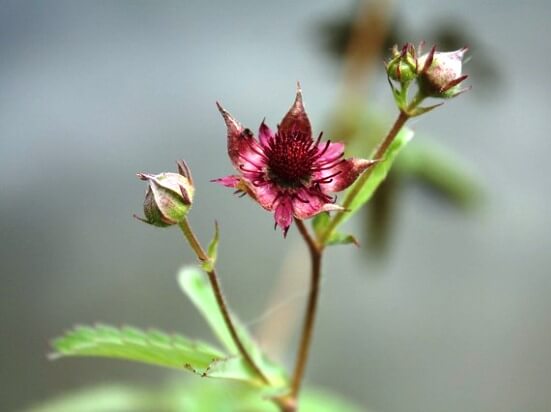
Height. Depending on the specific type, it can be from 15 - 20 cm to 1 meter. Some plants can reach 120 - 150 cm. It develops quickly enough.
Diseases and pests
In this regard, gardeners do not need to worry too much. The culture is not only easy to plant and care for, but also immune to many diseases and pests. If the bush does not bloom or dries, there may be few reasons. The main problem of this culture is a disease such as rust. It must be said that it often affects pine trees, therefore it is not recommended to place Potentilla in the immediate vicinity. The disease is expressed by yellow-brown spots on the leaves, which have a purple tint. With significant damage, the foliage curls and dries. Treatment with a composition containing manganese and boron, as well as sulfur, will help.

Application in landscape design
Without exception, all types and varieties of Potentilla are highly decorative. On any site, both shrub varieties and herbaceous varieties will look equally impressive.
Thanks to the formative pruning, the shrub cinquefoil will become a spectacular tapeworm that attracts the eye, and a hedge or a group planting of plants looks beautiful.
Low-growing five-leafed varieties are planted in flower beds, rockeries and rocky gardens, and herbaceous varieties are planted in flower beds in combination with other perennials. So, yellow cinquefoil looks nice with blue and blue flowers, red cinquefoil - with white and pink.
Absolutely any plants are worthy of being the "neighbors" of Kuril tea, except for pine, which, like the five-leafed leaf, can be affected by rust.
Unpretentious and at the same time attractive Potentilla can decorate a city park, flower bed or lawn, and on the garden plot it is worth highlighting a corner for this unpretentious plant. Even a novice florist can grow a wonderful shrub that will bloom throughout the summer season.
Lack of light
Often the solution to the problem of the lack of flowering of Potentilla lies in the lack of light. These plants prefer well-lit areas where the sun shines in the morning and a little shade prevails in the afternoon.
Attention! In a dense shade, the plant will not develop fully and will be susceptible to specific diseases. However, a large amount of direct sunlight adversely affects the life of the plant.
In this case, the flowers fade, the petals wither and fall off. An ideal place for Potentilla shrub will be an area with diffused light.
However, a large amount of direct sunlight adversely affects the life of the plant. In this case, the flowers fade, the petals wither and fall off. An ideal place for Potentilla shrub will be an area with diffused light.

Potentilla shrub loves abundant lighting
What does Potentilla consist of?
Speaking about the medicinal qualities of Potentilla white, it is worth noting that all parts of the plant have their own beneficial properties.
- Rhizomes are composed of carbohydrates, flavonoids, iridoids, tannins, phenolcarboxylic acids and saponins.
-
The aerial part contains flavonoids, iridoids, saponins.
- The foliage is rich in various phenol carboxylic acids, flavonoids.
- Seeds include protein, fatty oils, glycoside, as a result of the cleavage of which hydrocyanic acid is released.
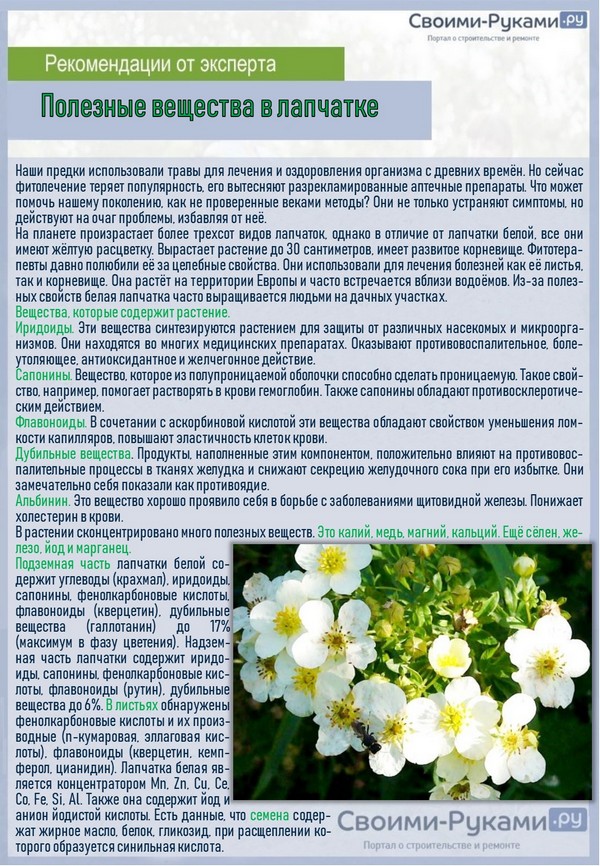
About minerals in Potentilla
The plant is able to prevent the development of negative processes, stabilizes metabolism and the activity of the endocrine system. Cinquefoil increases the tone and elasticity of blood vessels, normalizes blood pressure, has a positive effect on the heart muscle, removes manifestations of thyrotoxicosis (breathing problems, heart palpitations, excessive sweating).
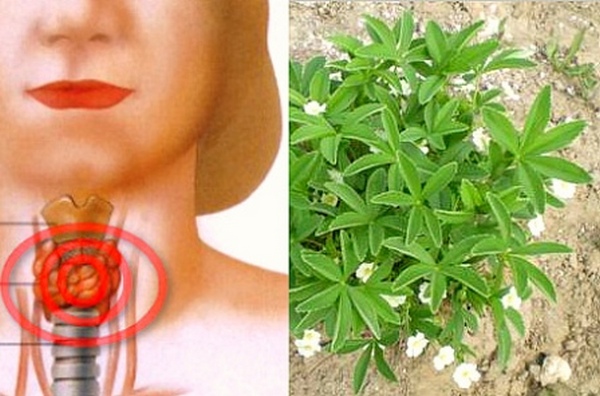
The healing effect of Potentilla is immediately visible
Medicines from Potentilla can speed up recovery, quickly restore a patient after heart attacks and strokes, remove radionuclides from the body and restore potency. The positive dynamics of the hormonal background stabilizes body weight, strengthens the protective functions of the body, and increases visual acuity. Eating Potentilla improves blood quality and heals ulcers.
The medicinal qualities of Potentilla have undergone clinical studies, but they still have not been recognized by official pharmacology.

Cinquefoil is more often used in folk medicine than in official medicine.
The plant shows itself on the positive side in the treatment of various kinds of diseases. Its thyrostatic effect has been proven by numerous experiments, and its ability to purify blood has long been beyond doubt.
Reproduction methods
Nepalese Potentilla is propagated in all common ways. If seeds are selected for this purpose, then they are planted almost at any time. Since sowing in most cases is carried out at home, providing the plant with the necessary amount of light will be a simple task.In principle, experienced gardeners are able to immediately plant seeds in open ground - with proper care, they will germinate quickly. The division of the bush is suitable for the Potentilla that has lived in the same place for at least 4 years.
Either in late spring or early autumn, you need to dig out the bush, and then divide it into several parts using a sharp tool
It is important that each one has at least a small number of roots and kidneys. Additionally, before disembarking, you should use a stimulant
Planting of plots is carried out immediately, and the gap between individual plantings ranges from 25 to 40 centimeters.


This procedure is carried out either in July or August. The scion used must be healthy and strong, and grow close to the ground. Having made a small incision on it with a processed tool, it is required to tilt the shoot to the ground and sprinkle the wound with soil for reliable fixation. Closer to autumn, the roots should already hatch, and a separate bush is transplanted into fertile soil. However, most gardeners still prefer cuttings.
Planting material can be collected all summer, but you only need to choose last year's and matured shoots. The length of one stalk is 9-10 centimeters. All the lower leaves will have to be torn off, and it is not forbidden to leave a few of the upper ones. The bottom of the cutting is treated with a stimulant, after which it is placed in a loose and light earth. Cuttings can be planted either in separate containers or immediately in the ground of a shaded area. A greenhouse is formed on top of polyethylene or plastic bottles. Regularly moistening the soil and removing the buds that appear, it will be possible to transplant the Nepalese Potentilla to a permanent habitat pretty soon.
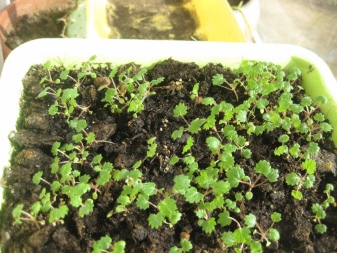
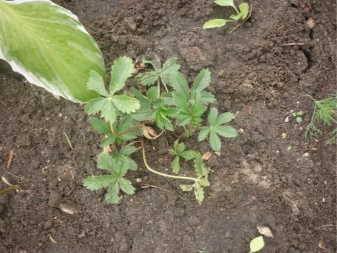
How to take care of it properly?
Cultivation of white cinquefoil requires some care, which is not difficult. It includes standard procedures:
- regular watering;
- loosening;
- top dressing;
- pruning.
Resilience and the ability to adapt allows the plant to survive in arid conditions. But it is better not to risk it and water it when the ground begins to dry out. One bush should take about 2 buckets. And if the summer turned out to be dry, the number of irrigations must be doubled. Weeds are best removed as they appear. Timely weeding and loosening allows you to saturate the roots with oxygen. But do not forget that they are located almost on the surface, and they can be easily damaged during the loosening process.
You need to feed the cinquefoil every spring, as soon as the first green leaves appear. Potassium sulfate or phosphate fertilizer is excellent for these purposes. The mixture is prepared from 30 grams of the substance per 10 liters of water. The feeding process does not cause any difficulties, but it provides lush flowering.
And if you want to provide your Potentilla with a long life, you need to provide it with additional fertilization in the very first month after planting. For this, gardeners use a mixture of one matchbox of urea per 10 liters of water.
Pruning is a must when it comes to shrub cinquefoil. She may be:
- formative;
- anti-aging.
The first type of pruning allows the shrubs to maintain a perfect rounded shape that will look great in any garden. In addition, it provides abundant flowering - over the summer, the number of flowers increases several times.
Formative pruning can be done in early spring or fall. We recommend the first option, because older branches will allow the bush to withstand frost better and withstand snow masses. And when the cold weather is gone and the snow melts, they can be removed. In the warmer regions of Russia, pruning is best done in the fall, because in the spring, gardeners have enough worries without it. To successfully prune, you need a fairly sharp pruner, as the branches can be up to one and a half centimeters in diameter.A bad pruner will only flatten them, which is undesirable.
Also arm yourself with a fan rake. With their help, it is necessary to clear the ground under the bush, removing grass and fallen old leaves.
Then you can start trimming itself. It is better to remove damaged and dry branches completely. The rest need to be shortened by one third or half, but no more. Make sure that the bush maintains a symmetrical rounded shape. After pruning, it must be treated with garden varnish.
Rejuvenating pruning is done every 5 years and is more radical. It is necessary to cut off all branches so that only a 20-centimeter stump remains above the ground from the bush. After that, the cinquefoil must be intensively fertilized so that the young branches grow back faster. Soon the bush will regain its beautiful appearance.
Both shrub and herbaceous varieties tolerate cold weather. You also need to cover seedlings planted in the fall. This ends the care for the white cinquefoil. Thanks to these simple actions, the bush can live in your garden for more than 20 years.
Phlox planting rules
How to choose healthy planting material
Before planting perennial phlox, it is worthwhile to dwell on varieties adapted for breeding in temperate climates.
Be sure to make sure that you are buying a plant with the desired bud color, so it is better to choose material with flowers that have not yet been cut.
When choosing a seedling, they examine it for the presence of diseases, check for rotting, pest damage on the roots. You need to buy a bush with well-developed roots, their length should be at least 10 cm.
Preparing the soil before planting
Phloxes love slightly acidic light soil. The clay is loosened with sand, and lime and ash are added to the acidic medium. Too poor soil is enriched with manure, compost.
If the planting of the bush will be in a new, untreated place, the earth around the hole must be dug to the depth of the shovel bayonet.
Choosing a place and soil for planting
If a site with a surface bed of groundwater, the planting site should be chosen on a hill, since the plant has a developed root system that goes to a depth of 20 cm, and groundwater can lead to decay of the roots.
There is an opinion among gardeners that it does not matter where phlox is planted, in the shade or in the sun. Slightly shaded areas where bright sunlight will not burn the seedling petals are most suitable.
The bush is planted on pre-fertilized, loosened soil.
Note! Low-lying areas should be avoided, as fog can accumulate in them, which causes damage to the leaves of the plant with powdery mildew. It is not necessary to plant the plant near large trees, as they will compete and take nutrients from each other
A tree with developed roots can kill a newly germinated seedling
It is not necessary to plant the plant near large trees, as they will compete and take nutrients from each other. A tree with developed roots can kill a newly germinated seedling.
Landing in open ground
If the place and time for planting phlox has been determined, then it is necessary to start planting. Phloxes are placed at a distance of 40-50 cm from each other. There should be 4-5 shoots on the bush with a length of 8 cm, roots at least 10 cm.
The depth of the pit should be from 30 cm, a mixture of compost, mineral fertilizers in equal parts is poured onto the bottom. The seedling is placed in the pit, spreading the roots.
Before planting phloxes in open ground, you need to soak the rhizome in a root growth stimulator for several hours. The growth point should be 3 cm below the ground.
Diseases and pests
Perennial shrubs of Potentilla rarely suffer from various diseases. This fact makes it very easy to care for the plant. But Potentilla cannot cope with ailments on its own.
- Spot - spots of various colors that appear on the leaves.Damaged leaves dry up and fall off ahead of schedule, which leads to disruption of the physiological processes of the plant. The cause of this disease is fungal infections.
- Rust - dirty red or yellow-brown spots on the leaves. After some time, pads are formed in place of the spots, hollow inside. The cause of the disease is a rust fungus, the spores of which are found in fallen leaves or neighboring plants. In spring, after ripening, they are spread by wind or insects.
- Powdery mildew is a fungal disease that affects foliage, shoots and petioles. It manifests itself in the form of a white bloom, on the surface of which drops of moisture appear.
These diseases are caused by spores of various fungi. And for the same reason, the shrub stops blooming, as the inflorescences dry up and fall off. But do not be upset, all these diseases are treated if you do not start the process. To do this, it is necessary to remove the damaged parts of the shrub (cut off). Sometimes you have to cut off most of the bush. After that, you need to treat the plant with fungicides, good, in our modern world there are many of them.
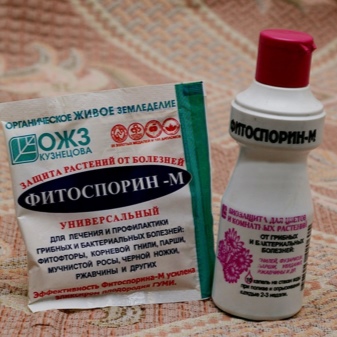

All varieties and types of Potentilla have a negative attitude towards transplantation. This is the only stressful situation for the plant. Most often, after transplanting, plants require careful care, otherwise the shrub dies. The principle of transplanting is very simple: a bush with a lump of earth is dug up and transplanted to a new place. Naturally, the hole is prepared in advance, the necessary vitamins and minerals are added to it in advance.


Views
Among the flowering shrubs, the cinquefoil shrub stands out for its luxurious golden long flowering of its numerous flowers, strewn with the bush "from head to toe."
Of more than 500 types of Potentilla, the most popular are:
grows up to half a meter in height, blooms luxuriantly with orange-red flowers.

Lоngacre
This species has bright yellow flowers.
Today, yellow varieties of Potentilla are more common, but rare ones are gaining more and more popularity - white, red, pink, orange varieties, there are even double flowers.
A creeping variety with pale pink flowers. Grows up to 60 centimeters in height.

Nepalese cinquefoil Potentilla nepalensis cultivar Miss Wilmott Miss Willmott
Perennial plant 50 centimeters high, with straight branched stems. It has rather long, finger-like leaves of a dark green color with a burgundy tint.
The flowers are light pink or dark pink, there are also varieties with red flowers. The diameter of the flower is about 3 centimeters. Panicle-shaped inflorescences begin flowering in July.

Silver cinquefoil Potentilla argentea
Perennial with a tuberous root system. Slightly curved stems grow up to 30 centimeters. Green leaf plates on the inside have a white edge. In the lower part of the stem, the leaves are 5-7-separated, the apical ones are 3-5-separated.
The flowers are small, yellow, in corymbose-paniculate inflorescences, up to 12 mm in diameter.

White cinquefoil Potentilla alba
Perennial, grows in height from 8 to 25 centimeters. The leaves are basal, complex-lobed, the flowers are quite large, up to 3 centimeters in diameter, white. Peduncles up to 25 centimeters long are in the shape of umbrellas or are collected in brushes.

Bushes up to half a meter in height, blooming profusely, with yellow flowers.

Pentaphylloides davurica shrub Pentaphylloides davurica
Grows up to 60 centimeters in height. 5-split leaf plates have a smooth green surface, pubescent from below with a pile of a gray shade. Flowers are solitary, also found in the form of umbrellas, white.

Pentaphylloides shrub Pentaphylloides fruticosa
It is a tall bush, up to one and a half meters in height, with stems covered with brown or grayish bark. The leaf plates have a solid, somewhat elongated shape of a pale green color, on which, over time, a light silvery fluff appears.
The flowers are golden yellow in color, up to 2 centimeters in diameter, clustered in the form of brushes or single. The plant is very hardy.



